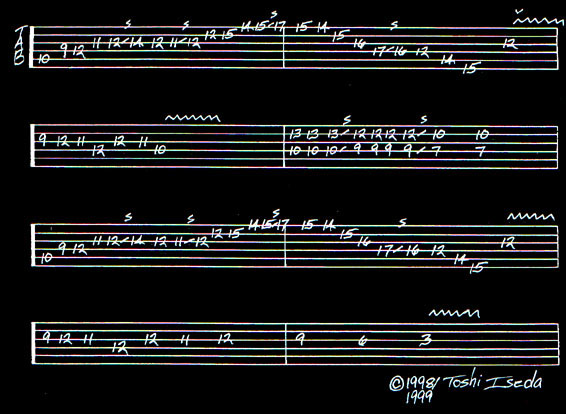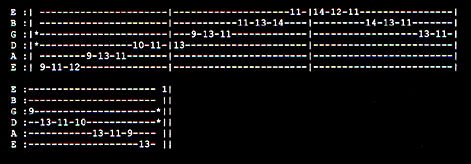

RYAN MAZA TOSHI IDEDA DAVE MARTONE FABIO MONTORZI
RYAN MAZA "Music Has Evolved"


TOSHI ISEDA "Intense Guitar"
 What
happenn' GuitarChef Readers !!!How's everyone doin' lately ?Good i hope !Been
practicing?Let's hope so!I have included in this tab the main melody line for
the chorus of "Custer's Last Groove".You can see how i also use
the A note in two different octaves as passing tones to go between arpeggio's.Hope
this helps you to venture into unknown arpeggio territory ... C-YA !!! For
contact and other things this is my official web site www.overthetop.com
.
What
happenn' GuitarChef Readers !!!How's everyone doin' lately ?Good i hope !Been
practicing?Let's hope so!I have included in this tab the main melody line for
the chorus of "Custer's Last Groove".You can see how i also use
the A note in two different octaves as passing tones to go between arpeggio's.Hope
this helps you to venture into unknown arpeggio territory ... C-YA !!! For
contact and other things this is my official web site www.overthetop.com
.

DAVE MARTONE "A Change Of Colour"
 Hello
Chef readers. Dave Martone here.
I have been asked to write a little column on modes.
I must start off by saying that there are no rules and nothing is right
or wrong. It is just different in how we perceive things with our ears.
Unfortunately, we have been trained throughout the centuries to rely
heavily on diatonic harmony. This
is great but everything starts to sound the same after a while as I am sure you
will agree ! I am going to talk about a mode that I hated and never thought was
useful until my ears grew up. I am
talking about melodic minor or 1,2,b3,4,5,6,7 . All it is, is a major scale with
a b3rd. I have a few ideas on how to use it and make it cool.
Let us first just use the chord F#7 for example.
Hello
Chef readers. Dave Martone here.
I have been asked to write a little column on modes.
I must start off by saying that there are no rules and nothing is right
or wrong. It is just different in how we perceive things with our ears.
Unfortunately, we have been trained throughout the centuries to rely
heavily on diatonic harmony. This
is great but everything starts to sound the same after a while as I am sure you
will agree ! I am going to talk about a mode that I hated and never thought was
useful until my ears grew up. I am
talking about melodic minor or 1,2,b3,4,5,6,7 . All it is, is a major scale with
a b3rd. I have a few ideas on how to use it and make it cool.
Let us first just use the chord F#7 for example.
C# Melodic Minor over F#7 chord

The
chord tones this gives us in relation to the chord F#7 are 1,2,3,#4,5,6,b7. Or
in other words the lydian b7 scale.
F# Lydian b7 over F#7 chord

Last
but not first, let us think about the chord Bb-7b5 and F#9.
The Bb or first chord tone of Bb-7b5 is the 3rd of F#, the Db
or second chord tone of Bb-7b5 is the 5th of F#.
The E or third chord tone of Bb-7b5 is the b7 of F#, and the Ab or fourth
chord tone of Bb-7b5 is the 9th of F#.
Basically they are the same chord but called differently due to the bass
note. Thus let us build a minor7th
flat5 scale starting of course on Bb.
Bb-7b5 scale over F#7 chord.

If
we look closely at each scale we realize that it is the same scale starting from
a different degree. Basically if we
start with C# melodic minor as the first, The F#Lydian b7 scale is the 4th
mode of melodic minor; as the Bb-7b5 scale is the 6th mode of melodic
minor. Basically we have looked at
the 1st, 4th and 6th mode of melodic minor and
worked them over a dominant chord . A
great way to remember it is to substitute a Lydian b7 scale starting on the root
of the chord. So if the chord is E7 we would play E Lydian b7 over it.
FABIO MONTORZI "Guitar Distortion"
 E
rieccomi a rompervi le scatelo con gli arpeggi ! Questa volta li affronteremo da
un altro punto di vista . Il metodo che sto per presentarvi consiste in una
tecnica molto cara ai chitarristi Neoclassici quali Malmsteen , Cacophony etc
... Il primo esercizio che vi propongo si tratta di un arpeggio di LAm eseguito
in tre modi diversi , la difficolta' principale sta nei continui String Skipping
e nel coordinare bene le plettrate . L'effetto che si ottiene e' abbastanza
particolare , infatti se si e' precisi nell'esecuzione si ottiene come un
"rimbalzo di note" (non ho trovato termini migliori ma provate per
capire !?) .
E
rieccomi a rompervi le scatelo con gli arpeggi ! Questa volta li affronteremo da
un altro punto di vista . Il metodo che sto per presentarvi consiste in una
tecnica molto cara ai chitarristi Neoclassici quali Malmsteen , Cacophony etc
... Il primo esercizio che vi propongo si tratta di un arpeggio di LAm eseguito
in tre modi diversi , la difficolta' principale sta nei continui String Skipping
e nel coordinare bene le plettrate . L'effetto che si ottiene e' abbastanza
particolare , infatti se si e' precisi nell'esecuzione si ottiene come un
"rimbalzo di note" (non ho trovato termini migliori ma provate per
capire !?) .

Questo secondo esempio riprende il concetto del precedente associandolo pero' all'accordo maggiore quindi ancora occhio alle pennate e alla precisione . Fate particolare attenzione a non toccare le corde sbagliate !!! Comunque potete visitare il mio sito ufficiale a http://fabiomontorzi.tripod.com .

news interviews lessons issues columnists links archive contacts
reviews cds new thanx to adv guest
© 2000 Site Design & Custom Graphics by Matt Cafissi - All Rights Reserved